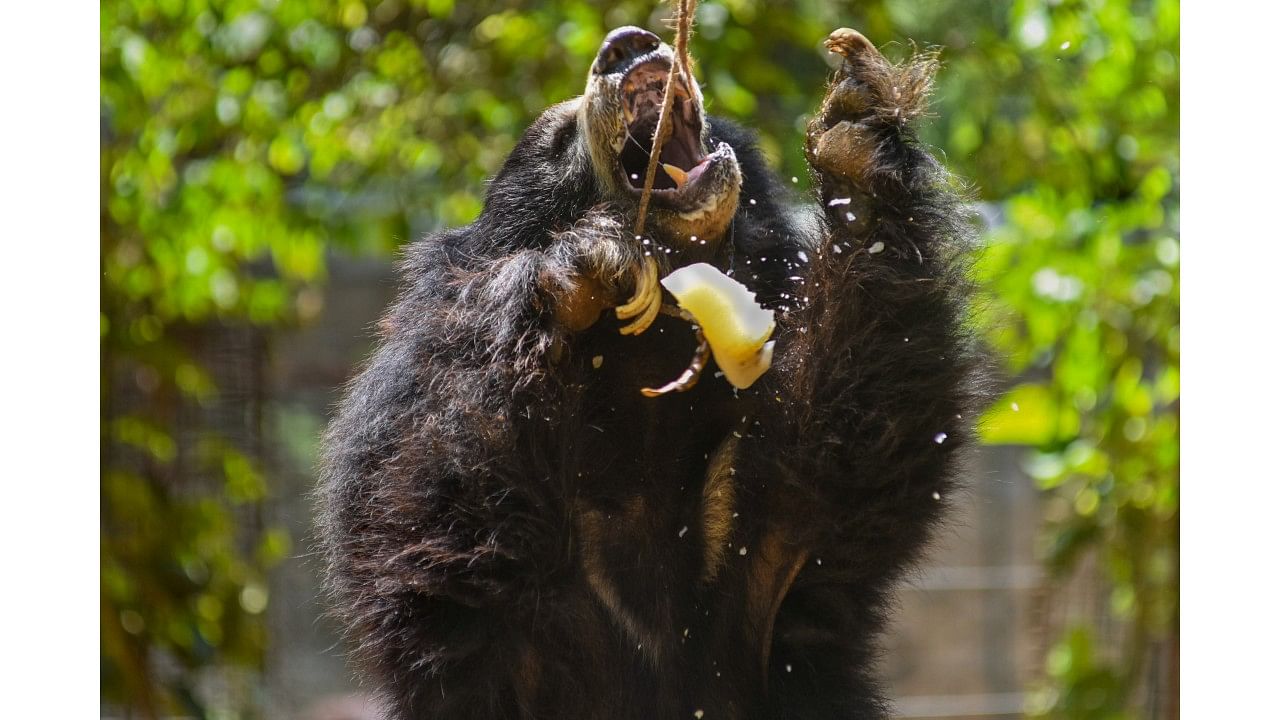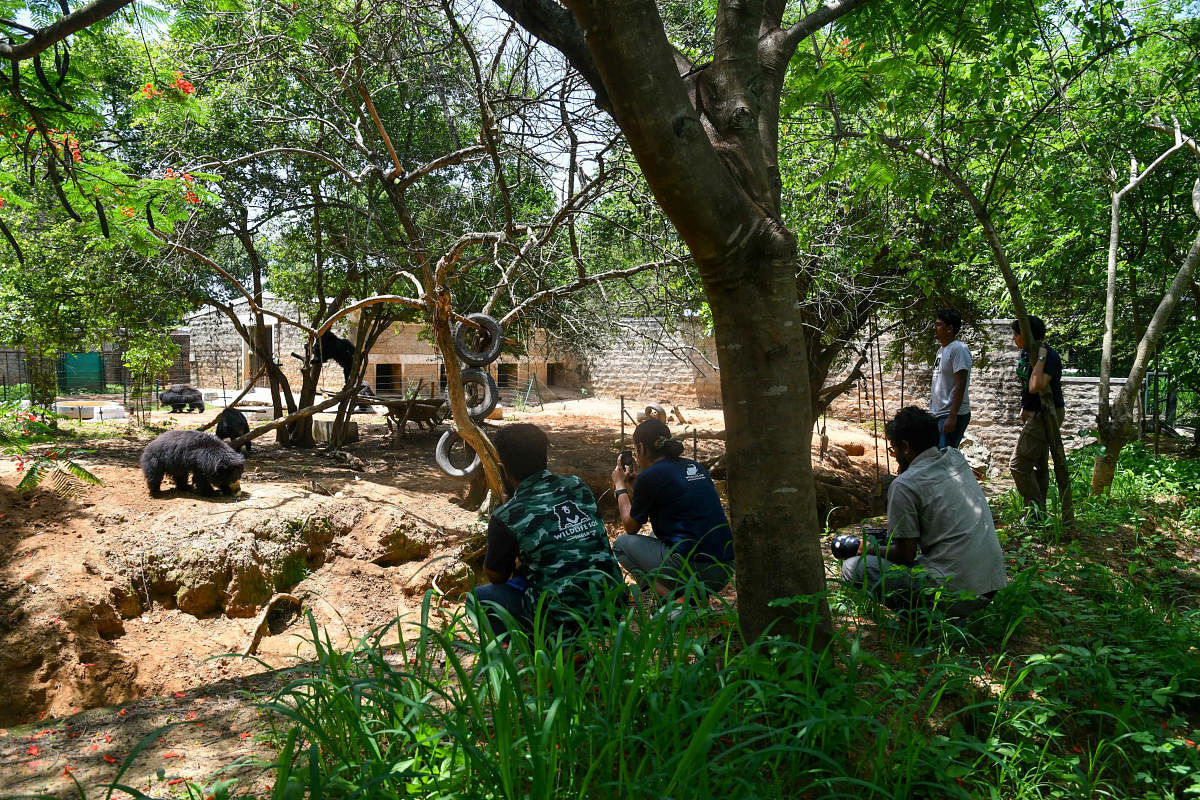

As I walk into the thick forests of Bannerghatta, 24 km from Vidhana Soudha in Bengaluru, a fresh morning breeze blows in my face and the sound of chirping birds slowly takes over from the sound of bustling traffic.
I am visiting the second-largest bear rescue centre in India (after Agra), spread over 75 acres of lush greenery. It is run by the Bannerghatta Biological Park in collaboration with the Bannerghatta Bear Rescue Centre, managed by an NGO called Wildlife SOS.
I hear growling. “It’s breakfast time for sloth bears,” an NGO staff says.
The sloth bear (Melursus ursinus) is endemic to the Indian subcontinent and is the most common of the four bear species found in India, widely spotted in the Western Ghats and central India. Baloo, Mowgli’s mentor in ‘The Jungle Book’, is speculated to be a sloth bear.
Breakfast scenes
Babu, who works at the centre as a bear caregiver, was busy mixing porridge, poured into about half a dozen steel plates. The bears were waiting for their first meal of the day. The porridge is a mix of jowar, eggs and mealworms, and is customised to meet each bear’s needs.
Babu pours a mug of diluted honey on top of the porridge to lure the bears to eat breakfast. The fictional Baloo loved honey, but in real life, a lot of honey can leave sloth bears with an upset stomach and so it is diluted.
The centre has 65 sloth bears, rescued from human-bear conflict situations, poachers, and also from the Kalandar community, which would use them for entertainment on the streets. These ‘dancing bears’ were kept captive, abused and taken from town to town. They were tied with a rope from the nose and made to ‘dance’.
The practice of dancing bears was declared illegal under the Wildlife (Protection) Act of 1972 but it was only in December 2009 when the last bear was taken off the streets or given to Wildlife SOS, according to news reports.
While the shaggy-coated and long-clawed sloth bear is protected under Schedule I of the Act just like the tiger and elephant, conservation campaigns focusing on them are fewer, making them vulnerable to abuse.
Sloth bears are often captured while they are young and they lose their natural instincts in captivity. They forget how to survive in the wild and develop no idea about how to care for their offspring. Bears at rescue centres are therefore not allowed to breed. Most bears in captivity also contract diseases such as tuberculosis from humans.
The lifespan of a sloth bear in the wild is 15-18 years but in captivity it extends to 30 years, thanks to stabler living conditions. Babu, who hails from the Kalandar community, had two bears with him. He and his bears were translocated to the centre in 2006, and he has been working there ever since. Wildlife SOS has employed several members of the community at its centres.
Treats aplenty
At noon, the sun is scorching, and it is time for their second meal. The bears are fed with popsicles made of fruit, milk, and water. Popsicles are often tied to the trees for the bears to encourage them to jump, grab and get some exercise. Sometimes, the staff hide the fruits between two trees for fun. The bears take no time to sniff them out. Sprinklers are turned on during hot days, and the bears are fed their favourite melons, dates and coconuts. Peanut butter is given on special occasions. Mealworms substitute for the ants and termites they would otherwise eat in the wild.
Most bears are left free, but the old and injured are watched closely. The free bears are part of the bear sanctuary of which visitors get a glimpse on the safari tour. Sometimes, spotted deer and wild boars stray into the bear area.
Some bears engage in friendly fights, and many need medical attention. Injured bears are lured with honey. As they slurp it up, doctors scan them and decide on the treatment. The medical centre is equipped to conduct surgery. Each bear’s health is recorded periodically, and weight, vaccinations and operations are tracked. Vets keep an eye on the bears to check for wounds.
The special one
As the day comes to an end, I meet a dwarf bear basking in the sun. He was named Odum by actress Julia Roberts on her visit to the centre in 2009. He was just seven when he was rescued from the Kalandar community and brought here. Kuber, Mithali, Hamsi, and Sundari are fellow bears.
As I head back to the city, I can’t help but think about the various challenges in animal conservation. Before visiting Bannerghatta, I had only heard about bears in cartoons like in ‘The Jungle Book’ and ‘The Yogi Bear Show’, epic stories, and also a Da Ra Bendre poem, which was incidentally on the dancing bears and the human instinct to exploit.
In literature
One of the popular cultural references to bears is of Rudyard Kipling’s ‘The Jungle Book’, where Baloo, the bear, is a mentor of sorts to Mowgli. Baloo teaches ‘Laws of the Jungle’ to the man-cub. Jambavanta, the bear, gets into a duel with Krishna in the epic ‘Mahabharata’. And in the ‘Ramayana’, Jambavanta helps Hanuman realise his capability to fly and join forces with Rama to find Sita in Lanka.
Life in captivity
Dancing bears went through immense trauma as they were taken captive at a young age. They were made to walk for miles without proper food, water and care.
Sanjay, 30, and Bobby, 29, the senior most bears at the centre, were taken captive by the Kalandar community when they were 12 and 16 respectively. Sanjay is slightly aggressive even now, after years of rehabilitation. Bobby is more friendly and non-dominating, but still finds it difficult to eat.
Common signs of trauma are weight loss, malnourishment, and obsessive behaviour like constantly swaying. To treat trauma, they are initially kept in a room and gradually released in a natural habitat. They are given nutritious food, care and medical check-ups.
Talisman
Hair from captured bears is removed and sold as a talisman.
Visit the rescue centre
It is open to visitors from 10 am to 5 pm on all days except Tuesday.
You can book safari tours to watch the bears in the wild from designated observation decks.
You can sponsor the daily and medical of a bear on a one-time, monthly or yearly basis. Monthly fee is Rs 3,500.
You can volunteer to cook food for the bears, hang tyre swings on the trees for them to play, or clean up the area where they stay.
(Details on wildlifesos.org)